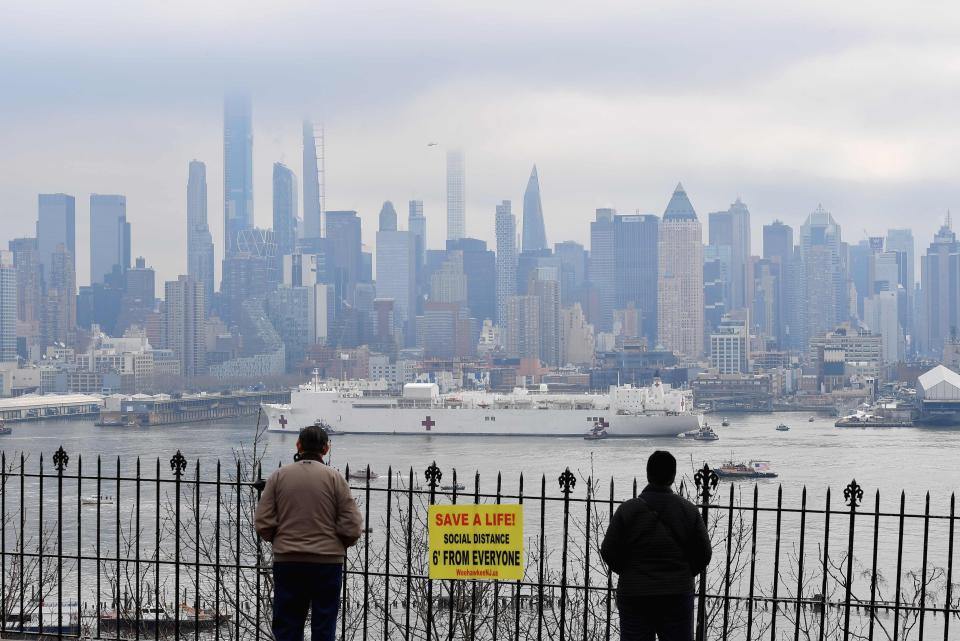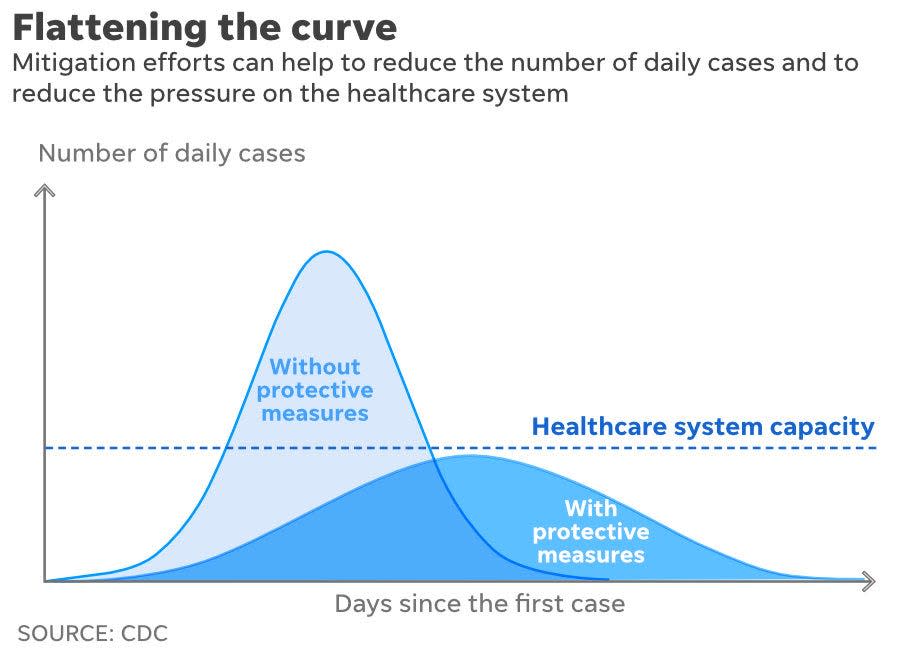What does furlough mean? Can I leave my home under shelter-in-place? Coronavirus terms, explained
Most people know what social distancing is by now. They've heard that the coronavirus outbreak has been declared a pandemic.
But what does it mean when you hear New York is the "epicenter" in the United States? And do health care professionals say they need ventilators or respirators – or both?
Three weeks ago, USA TODAY published a guide to new vocabulary words popping up as the new coronavirus spreads globally. As the situation around the world changes, new words have entered dinner table conversations and social media feeds.
Here's a look at other terms related to the coronavirus and what they mean.
USA TODAY's first coronavirus vocabulary guide: What is social distancing? When should I quarantine versus isolate?
Epicenter and 'hot spot'
While many headlines and public health officials have used the term "epicenter," the word doesn't comes from the field of public health.
According to Merriam-Webster's definition, an epicenter is "the part of the earth's surface directly above the focus of an earthquake." It can also mean the "center."
Coronavirus live updates: Amazon workers to strike; Virginians ordered to stay home; US deaths surge past 3,100
Speaking with Politico, Dr. Anthony Fauci, director of the National Institute of Allergy and Infectious Diseases, said the way the term has been applied during the coronavirus pandemic – to Wuhan when the virus broke out, followed by northern Italy then New York as more cases surged – may not be the most accurate use. However, he said it's still useful to understand "that point in a particular region where the most activity is."
“Is it the ‘focus’? Is it the ‘major point of acceleration’? Is it the ‘epicenter’? It’s the most prominent area with an outbreak,” he told Politico. “I don’t see any harm in using common terms. There’s always room for misunderstanding, but as long as it isn’t so confusing for people to understand, I have no problem with saying ‘epicenter.’”
Similarly, "hot spot" is not a public health term but has been used to describe areas with a particularly large cluster of cases.

Shelter-in-place and stay-at-home orders
State and local officials have tried to curb the spread of the disease by limiting residents' movement through shelter-in-place and stay-at-home orders.
Some states have called them shelter-in-place orders and others stay-at-home orders. The directives differ by location but generally require people to avoid all nonessential outings and stay inside as much as possible.
'Stay Home, Stay Healthy': These states have ordered residents to avoid nonessential travel amid coronavirus
The orders are not lockdowns and in general allow residents to continue performing tasks essential to the health and safety of family and pets. It's still fine to buy groceries, go for a run, walk the dog, pick up medicine, visit a doctor or get supplies to work from home.
Martial law
Martial law is "the law administered by military forces that is invoked by a government in an emergency when the civilian law enforcement agencies are unable to maintain public order and safety," according to Merriam-Webster. While social media rumors have spread of martial law being enacted amid the pandemic, it has not and government officials have given no indication it will be enacted.
Community spread
According to the Centers for Disease Control and Prevention, "community spread means people have been infected with the virus in an area, including some who are not sure how or where they became infected."
Is 6 feet enough for social distancing? An MIT researcher says droplets carrying coronavirus can travel up to 27 feet.
Contact tracing
Contact tracing is done by closely monitoring and tracking with whom a person infected with a contagious virus has come in close contact, according to the World Health Organization.
The process of contact tracing is done in three steps, per the WHO:
Contact identification: "Once someone is confirmed as infected with a virus, contacts are identified by asking about the person’s activities and the activities and roles of the people around them since onset of illness," the WHO says.
Contact listing: This involves listing every person who is a contact and communicating with them about the virus, risks and potential symptoms. "In some cases, quarantine or isolation is required for high risk contacts," the WHO says.
Contact follow-up: The WHO says contacts should be checked on to monitor for symptoms and test for infection.
Flattening the curve
Public health experts have argued for measures including social distancing and quarantine or isolation for symptomatic people in an effort to "flatten the curve," meaning slow the spread of the virus to prevent a rapid spike.
The goal of "flattening to curve" is to prevent the number of cases from exceeding the capacities of a health care system. Too many sick people at once, and there may not be enough beds or ventilators.

How coronavirus spreads so quickly: And how you can slow it down
Instead, the aim is to spread cases over a longer period of time so that they grow slowly and never peak above the health care system's capacity.
"Even if we can’t change the total number of people who are going to be infected, by keeping the total numbers low at any given time, that dramatically improves our ability to cope with the outbreak and in particular to provide care for the people who are going to be severely ill," Emily Gurley, an associate scientist in the Department of Epidemiology at the Johns Hopkins Bloomberg School of Public Health, told USA TODAY earlier this month.
Furloughs
Furloughs are temporary leaves from work without pay. They're different from being laid off because the intent is for the worker to return to the job after a set period of time.
Employers who have shuttered their businesses either due to local restrictions on what can be open or economic hardships may turn to furloughing employees to alleviate some of the economic impact of the pandemic, instead of firing employees, so those employees can return to work once the store re-opens.
Record unemployment: 3.3M Americans file for unemployment benefits as the coronavirus takes a big toll
Ventilator and respirator
A ventilator is a machine that helps someone breathe by getting oxygen into their lungs and removing carbon dioxide from the body. They are used for people with severe respiratory diseases and for those undergoing surgery.
'On-the-job emergency training': Hospitals may run low on staff to run ventilators for coronavirus patients
To operate, trained health care personnel are needed. "They're very complex machines, and you don't have enough respiratory therapists," said Thomas Frieden, a former director of the U.S. Centers for Disease Control and Prevention.
Respirators are masks or devices that keep potentially harmful substances out of inhaled air. A doctor may wear one when treating a patient with COVID-19 to prevent the virus from spreading through the respiratory droplets the patient produces when they cough.
Health care professionals treating coronavirus patients have said they face shortages of supplies of both respirators to protect themselves and ventilators to treat patients.
Vaccine
A vaccine prevents disease by stimulating "your immune system to produce antibodies, exactly like it would if you were exposed to the disease. After getting vaccinated, you develop immunity to that disease, without having to get the disease first," the CDC says.
Currently, there is no vaccine for the new coronavirus, but trials are underway. Most doctors say it will take at least a year to 18 months before one is available to most people.
Contributing: Grace Hauck, Lorenzo Reyes, Jorge L. Ortiz, Doug Stanglin, Kevin McCoy and Katie Wedell
Follow USA TODAY's Ryan Miller on Twitter @RyanW_Miller
This article originally appeared on USA TODAY: Coronavirus epicenter, hot spot, shelter-in-place, martial law defined

